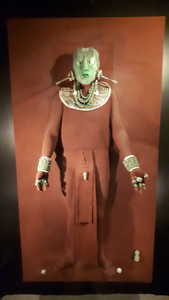The Ancient Astronaut of Palenque: Seeing Ghosts with Erich von Däniken
- Chris Gyford

- May 4
- 3 min read
Updated: Aug 16
“What does this relief have to tell us? Nothing? Is everything that anyone links up with space travel a stupid figment of the imagination?” – Erich von Däniken
“What does the stone relief of the rocket-driving god at Palenque mean?” asks Erich von Däniken (VD) in his 1968 bestseller Chariots of the Gods? (COTG?) “A genuinely unprejudiced look at this picture,” he answers himself, referencing the finest evidence he ever produced for ancient astronauts, “would make even the most die-hard skeptic stop and think.” And while the teenage me—enamoured by this convicted fraudster’s fanciful hypotheses—was certainly not a “die-hard skeptic,” the now fifty-year-old me—visiting Mexico on a birthday trip—may well be. So, let’s give this so-called astronaut an impartial gander.

Descending to view the faithful reconstruction of the royal tomb of Kʼinich Janaab Pakal I beneath the Maya exhibition hall at the National Museum of Anthropology (MNA) in Mexico City offers something conspicuously absent from VD’s presentation: cultural context. As extraordinary as the carving is, it's clear that this piece has been craftily cherry-picked from a rich corpus of similar artworks, many of which contain comparable symbolism, yet none of which resemble anything remotely astronautical. Further context coming from the displayed grave goods, with nary a space helmet nor ray gun in sight.
Misrepresented by VD as a relief of the god Kukumatz discovered in 1935, the carved sarcophagus lid in actuality depicts its regal occupant and was uncovered in 1952; a level of inaccuracy one might expect in a section on the Maya titled “Mysteries of South America.” To be fair, the Kukumatz misidentification originated with “white gods” proponent Pierre Honoré, while the extraterrestrial speculation came from ancient astronaut pioneer and VD rival Robert Charroux’s protégés, Guy Tarade and André Millou. So, the erroneous dating of the discovery and its continental relocation are VD’s only original errors here.
“One is not seeing ghosts,” VD maintains in his somewhat ironic defence, “when one is analysing actual objects.” That, however, is precisely what VD is doing here; I’ve written before about how our brains use top-down visual processing based on our expectations from cultural learning and prior experience to interpret what it is we are seeing, and just as we can interpret shadowy figures in dimly-lit locations as apparition so too can we interpret complex symbolic artworks from alien cultures as, well, aliens.

“Today,” writes VD of Pakal in a particularly revealing comment, “any child would identify his vehicle as a rocket.” This statement not only highlights the extraordinarily shoddy evidential basis of VD’s epistemology but also reveals his cultural, and indeed temporal, chauvinism. As, not only do I doubt that a 7th-century AD Mayan child would interpret it as such, I also doubt that any child raised outside a brief cultural moment dominated by imagery from NASA’s Mercury and Gemini programs (the only contextual references VD offers), and the pulp sci-fi of Flash Gordon and John Carter, would do so either.
“It is not our fault,” opines VD, “that the stone relief from Palenque exists.” And indeed, it is not; in fact it’s not even his fault that it has been so mischievously misrepresented in a racist revisioning of history (that dishonour belonging to Honoré). It is however his fault that it continues, to this day, to be used in the promotion of pseudoscientific nonsense and attacks on genuine scientific research and scholarship, as highlighted in his claim, “If the stone relief from Palenque is also rejected from the chain of proofs, one must doubt the integrity which scholars bring to the investigation of outstanding finds.”
The absolute failure of VD’s analysis is highlighted by the presence (albeit somewhat obscured in the reproduction in COTG?) of the image of a bird perched on the nosecone of Pakal’s rocket. Tim Ferris confronted VD with this apparent anomaly in a 1974 interview for Playboy, which remains one of the only times VD has opened himself up to direct questioning from a well-informed skeptic. “Oh, I don’t know,” he responds, as his signature insistence on an entirely literal interpretation, filtered through his own limited understanding, instantly collapses, “Perhaps it represents flight, you know?”
































Comments